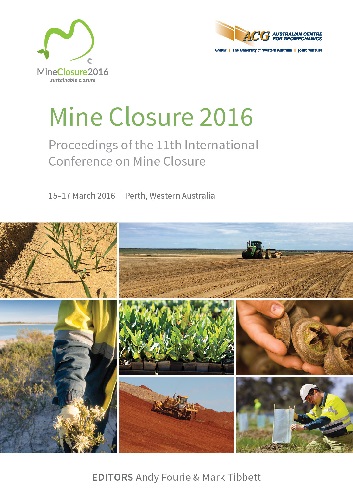Mine closure experiences — Bolivia, South America

|
Authors: Cárdenas, A |
DOI https://doi.org/10.36487/ACG_rep/1608_52_Cardenas
Cite As:
Cárdenas, A 2016, 'Mine closure experiences — Bolivia, South America', in AB Fourie & M Tibbett (eds), Mine Closure 2016: Proceedings of the 11th International Conference on Mine Closure, Australian Centre for Geomechanics, Perth, pp. 707-714, https://doi.org/10.36487/ACG_rep/1608_52_Cardenas
Abstract:
Bolivia is a well-known mining country, mainly because of its rich tin, silver and gold deposits mined since the Jesuit and Spanish times; 17th to 18th centuries. There are three types of mining sectors: private, state and cooperatives. Within the private sector four closures took place on the highlands: Kori Kollo (Golden Hill) and Kori Chaca (Golden Bridge) projects both located in Oruro, COMCO silver heap leaching Project located in Potosí; and Puquio Norte Gold Project located in the lowlands of Santa Cruz, agitation leaching operation. Within the state sector, there were many mining operations with mine waste and tailings abandoned but not closed. However, in order to mitigate the pollution the Bolivian Government, together with some international donors such as the Danish International Development Agency, have prioritised and encapsulated some tailings deposits in the Potosí Prefecture. The cooperative or artisanal mining sector lacks mine closures. Neither the government nor the communities have forced them to comply with the environmental mining regulations, which have been in force since 1997. Therefore, there are many environmental issues on the sites operated by artisanal miners. This paper reviews the results of the closure efforts of the gold and silver heap leaching operations on the highlands of Oruro and Potosí, where pits, mine waste, evaporation ponds and tailings storage facilities were closed. The paper also addresses another gold agitation leaching operation, in the rainforest which was also closed. In all cases, closure plans and monitoring programmes were executed. Special focus was placed upon the physical and chemical stability of closed facilities so that no further effluents would be released and therefore no major threats would be expected to the environment and nearby communities.
Keywords: mine closure, environmental mining regulations, monitoring programs, heap leching operation, pollution and prevention measures
References:
Arce, O 2009, Metalliferous Ore Deposits of Bolivia, La Paz, Bolivia.
Cardenas, A 2003, ‘Legal Framework for Mine Closure’, Debate Forum, Environmental Management of Terminal Mining Projects, La Paz, Bolivia.
MMM (Ministry of Mining and Metallurgy) 1997, ‘Environmental Regulations for the Mining Activities’, Supreme Decree No.24782, La Paz, Bolivia.
Oporto, H 2012, ´Mining Dilemas´, Fundación Vicente Pazos Kanki, La Paz, Bolivia.
Schlumberger Water Services 2009a, Kori Kollo Mine, Closure and Reclamation Plan, La Paz, Bolivia.
Schlumberger Water Services 2009b, Kori Chaca Mine, Closure and Reclamation Plan, La Paz, Bolivia.
VMMH (Vice Ministry of Mining and Hydrocarbons) 2001, Environmental Guideline to closure, remediate and rehabilitate mining activities areas, VMMH and the International Development Canadian Agency.
WB & IFC (World Bank and International Finance Corporation) 2002, ‘It’s Not Over When It’s Over: MINE CLOSURE AROUND THE WORLD’, MINING AND DEVELOPMENT, Global Mining, World Bank and International Finance Corporation, Washington DC.
Yujra, F 2014, ‘Study Trip to Puquio Norte - Santa Cruz’, Students of the Metallurgy Career of Universidad Mayor de San Andres, La Paz, Bolivia.
© Copyright 2025, Australian Centre for Geomechanics (ACG), The University of Western Australia. All rights reserved.
View copyright/legal information
Please direct any queries or error reports to repository-acg@uwa.edu.au
View copyright/legal information
Please direct any queries or error reports to repository-acg@uwa.edu.au